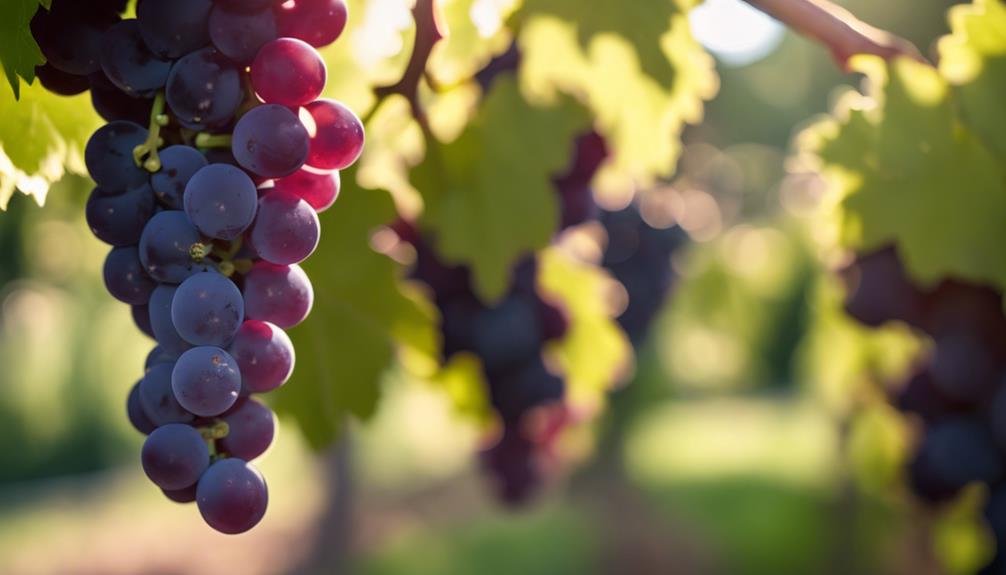Reveal the mysteries of Cabernet Sauvignon: Its diverse flavors are shaped by climates and soil, while aging potential is influenced by terroir. Pair it with aged cheddar or ribeye for a perfect match. Did you know it's a blend of Cabernet Franc and Sauvignon Blanc? Discover unique aspects like terroir's impact on flavor and the allure of well-aged wines. Explore insights into production methods that shape its quality. These hidden gems will enhance your appreciation for this elegant wine, enticing you to savor its complexities and stories further.
Flavor Variations of Cabernet Sauvignon
Cabernet Sauvignon exhibits a diverse range of flavor profiles influenced by the climates in which it is grown worldwide. Soil influence plays a significant role in shaping flavor nuances, with variations in mineral composition impacting the taste of the grapes.
Additionally, the aging potential of Cabernet Sauvignon is influenced by terroir, the unique environmental factors of a vineyard, such as soil, climate, and topography. These terroir impacts contribute to the complexity and character of the wine as it matures.
Understanding the terroir of a region can help predict how a particular Cabernet Sauvignon will develop over time, highlighting the importance of factors beyond grape variety in the creation of exceptional wines.
Perfect Food Pairings for Cabernet Sauvignon
An essential aspect of enhancing the tasting experience of Cabernet Sauvignon lies in skillfully pairing it with complementary dishes that accentuate its robust flavors and structure.
When considering wine and cheese, opt for aged cheddar or gouda to complement the wine's tannins, or blue cheese for a bold contrast.
For steak pairings, a juicy ribeye or filet mignon pairs excellently with Cabernet Sauvignon, enhancing the savory notes in both the wine and the meat. The rich umami flavors in steak harmonize with the wine's dark fruit undertones, creating a delicious combination.
Intriguing Facts About Cabernet Sauvignon

One fascinating aspect of the renowned red wine grape, Cabernet Sauvignon, is its intriguing historical lineage and genetic composition. Cabernet Sauvignon has its historical origins as a natural crossing of Cabernet Franc and Sauvignon Blanc, leading to its unique characteristics.
This grape variety is known for its aromatic compounds, with the green bell pepper aroma often linked to pyrazines found in unripe grapes. Additionally, American Cabernets can legally contain up to 25% of other grape varieties, adding complexity to the wine.
Furthermore, the high demand for Cabernet Sauvignon wines contributes to their premium prices in the market. Each year, wine enthusiasts celebrate Cabernet Day, a tradition that has been observed annually on the Thursday before Labor Day since 2010.
Insights Into Cabernet Sauvignon Production
Exploring the intricate process of cultivating and harvesting Cabernet Sauvignon reveals the meticulous care and specialized techniques involved in its production. Vineyard techniques play an essential role in shaping the quality of Cabernet Sauvignon wines. Pruning methods, canopy management, and soil composition directly impact grape development and flavor profiles.
Additionally, the climate impact is significant as Cabernet Sauvignon thrives in regions with minimal rainfall and specific temperature ranges. Eastern Washington State and Champoux Vineyards in Washington exemplify ideal climates for cultivating this grape variety. Surprisingly, even the Gobi Desert in China hosts wineries successfully producing Cabernet Sauvignon.
Understanding and implementing these vineyard techniques while considering the climate impact are essential steps in producing exceptional Cabernet Sauvignon wines.
Unique Aspects of Cabernet Sauvignon

After exploring the intricate process of cultivating and harvesting Cabernet Sauvignon, it becomes evident that this renowned grape variety possesses unique aspects that set it apart in the world of wine production.
One of these distinct features is the influence of terroir on Cabernet Sauvignon grapes, where factors like soil composition, climate, and topography impact the wine's flavor profile.
Additionally, Cabernet Sauvignon is known for its exceptional aging potential, allowing it to develop complex flavors and aromas over time. This aging process can enhance characteristics such as tannins, fruit intensity, and overall structure, making well-aged Cabernet Sauvignon wines highly sought after by wine enthusiasts.
Understanding these unique aspects adds to the allure and appreciation of Cabernet Sauvignon in the domain of winemaking.
Frequently Asked Questions
How Does Cabernet Sauvignons Flavor Change With Aging?
As Cabernet Sauvignon ages, oak influence integrates, enhancing flavors with vanilla, spice, and toasted notes. Tannin structure softens, allowing fruit and savory characteristics to harmonize. Extended cellaring develops complexity, revealing secondary aromas like leather and tobacco, showcasing the wine's cellar potential.
What Impact Does Terroir Have on Cabernet Sauvignon Taste?
The taste of Cabernet Sauvignon is profoundly influenced by terroir, encompassing soil composition, climate, vineyard location, and altitude. These factors impart unique characteristics to the grapes, shaping the flavor profile of the resulting wines.
Are There Any Famous Myths or Legends About Cabernet Sauvignon?
Historically, Cabernet Sauvignon's origins are linked to a natural crossing of Cabernet Franc and Sauvignon Blanc. Culturally, it holds significance as a noble grape variety. While myths exist, its reputation for bold flavors and aging potential remains paramount.
How Do Winemakers Prevent Ladybug Taint in Cabernet Sauvignon?
To prevent ladybug taint in Cabernet Sauvignon, winemakers utilize meticulous harvest strategies to avoid unintentional entry. Additionally, they may employ targeted chemical treatments to mitigate any contamination risks, safeguarding the wine's flavor integrity and quality.
Can Cabernet Sauvignon Grapes Be Grown in Unique Climates?
Cabernet Sauvignon grapes can thrive in unique climates due to their adaptability. Winemakers experiment with different soil compositions and vineyard techniques to produce distinct flavors. Climate variations play an essential role in shaping the grape's characteristics.
Conclusion
In the intricate world of Cabernet Sauvignon, each glass tells a unique story of dark fruit essence, herbal notes, and floral aromas. From Bordeaux to California, this noble grape varietal enchants with its rich tapestry of flavors.
Pairing perfectly with charred gruyere burgers or marinated ribeye steaks, Cabernet Sauvignon's savory character shines. Uncover its surprising parentage and annual celebration, as its legacy continues to flourish in vineyards and cellars worldwide, engaging wine enthusiasts with its secrets and splendor.